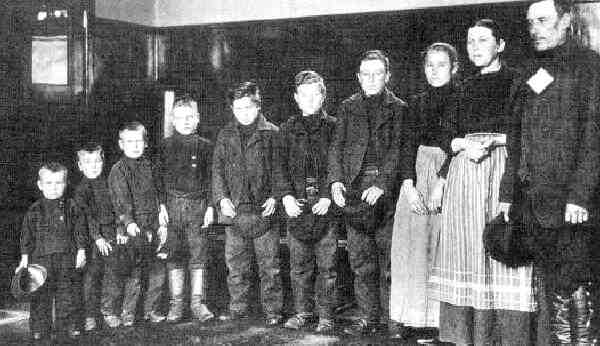The Russian Empire was the largest, most populace European state. Given that and the fact that the country had a huge largely suppressed population--the serfs. Tsar Alexander II emancipated the serfs (1861). But they continued to e a suppressed population into the 20th century. You would think that this would mean that large numbers of Russians would have been involved in the waves of Europeans that emigrated to America in the late-19th and early-20th century. This did not occur, at least for ethnic Russians. Very small numbers of ethnic Russians emigrated. In fact fewer than those that came from many small European countries. There were a range of issues involved here. Russia did not become a nation state until the fall of Communism (1992). Russia in the 19th century when massive numbers of European immigrants came to America was a multi-ethnic/national empire. One of three great empires that controlled most of Eastern and Central Europe The others were: the Austro-Hungarian, Ottoman, and German Empires. Other European states had empires, but not in Europe.) The Russian Empire was the largest, European Empire, but only about half the population were ethnic Russians. The well off population saw no need to emigrate. The former serfs were not as well educated as Western Europeans and did not understand the potential opportunities. Nor did Tsarist officials and the aristocracy (which owned mosb of the land) want the former serfs to emigrate. They were needed to work the land. Without the former serfs, the land had no value. An important factor during the 19th century was that serfdom prevented significant immigration on the part of the peasantry until the 1860s. The serfs after 1861 were no longer tied to the land legally, but there was a continuing emotional tie. The Orthodox Church was another emotional tie. And since the days of Mongol control there was deep-seated fear of outsiders/foreigners. Russians did not trust the West, especially non-Orthodox Westerners. This feeling was so pervasive and deep seated you can still see it today in Putins's monstrous campaign against Ukraine. The majority of Russians believe that Ukrainian have no right to a national existence and all the trouble is being stirred up by the evil West. This is not to say that immigrants did not come from the Russian Empire, only that it was not ethnic Russians who came. And even the Russians living in Alaska returned to Russia after the American purchase (1867). There was, however, substantial immigration from the Russian Empire, only it was the religious and ethnic minorities in the Empire that emigrated. This included Poles, Jews, Balts, Ukrainians, and many other nationalities, even some Germans. The two most important groups were the Jews and Poles. The primary impetus for Russian Jewish immigration to America were the Tsarist pogroms directed at Jew in the wake of the assassination of Tsar Alexander II (1881). A substantial proportion of the Russian immigrants were Jews. This was the largest group of European Jews to come to America. Earlier Jewish immigrants had been primarily German, but they were relatively small in number compared to the numbers of Russian Jews that began to arrive in the 1880s. Many Russian Jews settled in New York and Pennsylvania. Most were poorly educated and unskilled and did not speak English. As a result, they had take poorly paid jobs in factories and mines. Some trade unions refused to accept Jews. As a result, many joined more radical unions such as the International Workers of the World (IWW). Russian Jews also became active in Socialist unions as well as the anarchist movement. Many Jewish immigrant girls and young women were killed in the Triangle Shirt Waist Factory Fire (1911). While large numbers were Jews, the Russian migration also added to the religious diversity of America by adding Orthodox Christians.
HBC

Navigate the Boys' Historical Clothing Web Site:
[Return to the Main U.S. immigration: Tsarist Era page]
[Return to the Main U.S. immigration page]
[About Us]
[Introduction]
[Activities]
[Biographies]
[Chronology]
[Cloth and textiles]
[Countries]
[Garments]
[Girls]
[Photography]
[Topics]
[Bibliographies]
[Contributions]
[FAQs]
[Glossaries]
[Images]
[Links]
[Registration]
[Search]
[Tools]
[Boys' Clothing Home]
Created: 9:20 PM 4/6/2024
Last updated: 9:20 PM 4/6/2024



